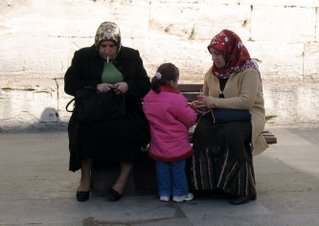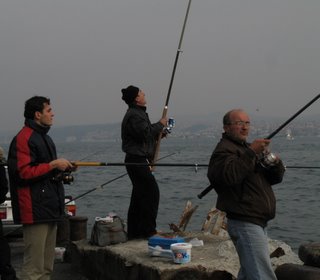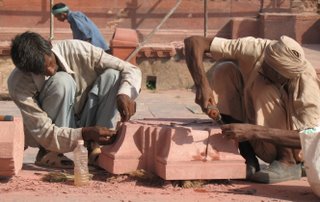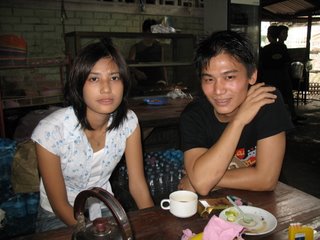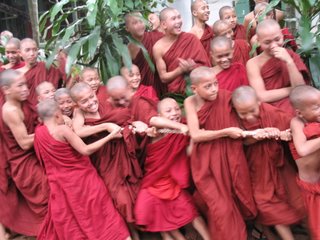
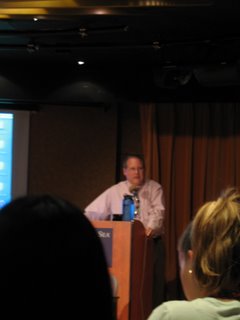
Semester at Sea has set for itself an ambitious academic goal, each student taking three demanding three hour courses and a three hour common course called Global Studies. Global meets every day the ship sails, for forty-four days total, each day for 75 minutes, 600 students deposited around the ship, in a large theater, in ten classrooms, in a popcorn/piano lounge. The question: how to do this in relevant and compelling ways, ways in which students and faculty will stay interested and gain meaningful information that enriches our travels and lives.
The problem this voyage? It didn't work as well as we had hoped. I thought about all this intensively for most of the trip, and wrote two epistles, sending them to various powers that be on and off ship. Here, for the elucidation of my dear readers, they are. Let me warn you: this is a long treatise. Skip it if you tire easily of one guy's ranting. The pictures are of the Global Studies coordinator political scientist Prof. Dick Farkas and of one faculty member, psychologiest Prof. Tim Kasser and his panel of kids on International Day of the Child, meeting for Global Studies.
Installment One: Written about one month into voyage, in hope that putting my concerns into words might effect some change.
27 Sept. 2006
As I watched Dick (Global coordinator) try valiantly to fill Tuesday’s seventy-five Global Studies minutes with interesting and important thoughts on Vietnam, I began to wonder about how much student learning is going on. I’ve spent the better part of the last month watching students in satellite classrooms and the piano lounge during the GS time, and have to conclude that, in spite of the worthy efforts of Dick and all the other lecturers, the current GS model is not working. Most students turn the lecture off after twenty or thirty minutes and then turn to their computer screens, on which they are not recording their notes on the lecture. Let me try to explain why I think this happens and why GS needs more alteration.
First, some premises, assumptions, principles:
First, long lectures, even in the hands of charismatic teachers, are associated with decreasing attention. The human attention span is very short, probably less than ten minutes. I will not advocate that we cater to that, just that we acknowledge it. It’s something that will not be able to change. It is something that can be incorporated into a revised plan for GS.
Second, long lectures impart information that is retained for short periods of time. Another way to put this is to say that what is learned is quickly unlearned, unless it is immediately reinforced, processed, manipulated, internalized, adapted, accommodated, etc. Long lectures offer little or no chance for such processing.
Third, individuals learn and retain more when it is actively discussed, written about, manipulated, etc. This means rather immediate processing, not delayed for one or five or more hours. By that time, details have been forgotten, short term memory has failed. The “I’ll be in classroom 8 at 5” solution is not a solution. Sure, some students do take advantage of this opportunity, but the majority do and will not. And a seven hour delay is just too long.
I believe that education happens when three things are present: one, information; information can be presented through lecture, reading, research, etc. Two, skill; skills develop when individuals manipulate information repeatedly with a coach to give expert feedback. And three, individual understanding. Understanding happens when information and skill get married and internalized by individual learners. (Credit to Adler, Sizer)
I believe that there’s a way to capture all three of these components in GS, at the same time that the larger chunks of the entire SAS curriculum become more fluidly interconnected.
Two things would have to happen:
One, faculty would have to get together to discuss the common curriculum. That would mean that the entire faculty would, under Fil’s leadership, decide on common themes, common books, common films, and some common dates. This may be near impossible now, but perhaps doable for the future, for future voyages. As a result of such collaborative interaction, important parts of all or most courses, as well as GS, would address certain texts (books, films, articles, poems, artifacts) or issues or themes at approximately the same time. (City and school common book experiences come to mind.) A more cohesive total curriculum would advantage the students and intensify the learning because it would provide the opportunity for students, faculty and staff to see a particular issue from the perspectives of several disciplines, which, for me, is the very essence of a liberal education. And it would focus most classes and GS on a more limited set of ideas, allowing for more intensive examination of those ideas.
Two, GS would offer shorter lectures in “active” learning environments. By active learning environment, I mean places where the lecturers’ audience would have more timely opportunities to process the content of the lectures.
I can think of several ways this timeliness could happen:
A. Every 15 or 20 minutes, the lecturer would pose a question or define a problem that arises out of that particular lecture. Students would then be given five minutes to discuss it with those who are sitting around them. Faculty and staff would be strategically placed in classrooms to enhance these. I’ve seen this work wonderfully well in large group settings of 300-600 in an audience.
B. The 75 minute GS period would be split into two parts, 35 minutes of lecture and 35 minutes of small group “active” learning (with five minutes for group movement). Faculty paired with staff would meet with these small groups in classrooms and open spaces. Each 35 minute lecture would be connected to a preplanned activity in these small groups; these would include things like role playing tied to social conflicts in particular countries, values clarification exercises, examination of case studies, games, reacting to discussion questions, etc. Lecturers would plan these active learning opportunities.
C. I’ll call this the Anthropological/Ethnographic approach (credit to Joan for this idea), where students become researchers in the countries they visit, creators of information, instead of just consumers of information (which is what they are now in GS). This seems to be the most radical of these three approaches, and certainly the most challenging. Obviously, at least two things would have to change from the present arrangement: the in-country or on-ship research that students do would demand that they present their results AFTER they return from a port visit. The practice now seems to be that post-port, the focus moves to the next country; and GS would have to equip students to ask good questions and to gather information. Can you imagine a presentation on “How to see a market” or “What to look for during a home visit”?
The 50 question testing approach, geared to an emphasis on student control and information consumption, would not fit this new model. I have serious troubles with the short answer test, even as one must acknowledge that it seems to fit the necessity of large group education. The normal distribution curve results we saw a few weeks ago destines 50% of the student body to grades of C and below. That defeats and discourages students, a cost much higher than the benefit of learning what one knows or doesn’t know. I believe that most or all students can be successful learners, even in GS type classes.
If something like approach B (with two 35 minutes periods) were used, attendance and completion of small group exercises would be sufficient for a passing grade (I’d drop the letter grading and move to a pass/fail system). The pass/fail system with active learning would increase both student and faculty morale, decreasing student apathy and resentment. Pairing faculty and staff in the small group discussion/case study/role playing/game sessions would bring faculty, students and staff closer together and enrich the total learning environment.
Let me be clear: I am not against lecture. I believe that lecturing is a wonderful way to present information and inspire, but only when it is in the hands of a competent and knowledgeable speaker, and when it is paired with active learning opportunities like I’ve sketched out above. But the most compelling reason to seek some of the changes I’ve suggested is the need for GS to offer a more common curriculum and to reflect a more diverse set of learning styles on the part of students. (Gardner, Bruner) I don’t believe that fully half the students cannot learn with excellence in GS, and be rewarded for it in the form of higher grades (or simply passes). I do think that faculty naturally lean toward lecture and are often lacking when it comes to trying out alternative and more creative, engaging curricular strategies. I’ve noted that faculty sometimes resist innovative teaching based on an unfortunate and blanket demeaning of pedagogy, or just ignorance thereof.
Many faculty probably fear that opening up the GS lecture to student interaction and increased ownership would lead to chaos. From my own experience I think the opposite is true. Faculty, students and staff can be educated to “make” such a plan work, engaging more students in learning. In fact, I think the risk of disaster is much greater under the present system, where student questioning is suppressed and marginalized. Further, as some other faculty have mentioned, letting UVA shape the curriculum in absentia is highly counter-productive – it’s the faculty, students and staff on board the ship who know what can and will work. We’re seeing a dangerous form of micro-management.
I hope this note puts some bones on earlier statements I’ve made about Global Studies and helps us all to see and enact a more workable and successful course of study.
Installment Two, written close to voyage end
Rethinking Global Studies and the SAS Curriculum
11-16-06
By now, week twelve of fall 2006, it’s clear that while Global Studies has stabilized and student resistance diminished, the form that it has now taken, and the form established for the past decade and more, is outdated and dysfunctional. It is time for a collaborative assessment by the faculty and, with agreement, for communication to ISE of some alternative action for future voyages. The reason an assessment is needed is that GS is an educational “dinosaur. “ I’d like to explain why I think it has failed and to spell out some more workable alternatives. I do not think any failures of the program are centrally attributable to its director. Given the form GS has persisted in over the years, any director will face an almost impossible uphill battle, unless the assumptions undergirding the program are examined, challenged and changed. I certainly don’t have all the answers, but I think I can raise some important questions.
The Problem: As I explained in my first note (see note of Sept. 27 sent to Fil Hearn and Dick Farkas), “bulking” and “loading” information into students’ heads, in the form of 75 minute single-faculty or multiple-faculty lectures, even with 10-15 minutes of time at the end left for questions, or a five pm classroom follow-up for anyone who want to come to raise questions, leaves no real time for student reflection and processing of information. And such bulking through lecture is the form GS has taken for many years, the dinosaur. Couple that with four 50 question multiple choice examinations and demanding lectures that ask for complex conceptual understanding and memorization from students, many of whose minds cannot grasp such complexities, and one is asking for trouble. Assuming that learning happens merely through the accumulation of information via reading and listening, in the absence of time for active reflection, analysis and synthesis, is flawed. Decades of scholarship have replaced such an assumption with more workable alternatives.
A conversation with F06 psychology faculty member Tim Kasser about the psychologist Mihaly Csikszentmihalyi puts these thoughts into clear terms and offers some alternative assumptions about learning. Csikszentmihalyi studied the “flow” which engaged persons experience when deeply immersed in a task and suggests that learning requires personal investment on a task perceived as interesting, meaningful and challenging. In contrast, GS requires students to internalize immense amounts of information without offering them opportunities to practice and master the skills required to do that and far too often results in anxiety and/or boredom. We see those results in the diminishing attendance at GS, the continuing bad feeling, the low scores on the examinations, and the occasional outbursts from students.
Further, cognitive psychologists tell us that individuals can hold only two or three complex ideas in their heads at one time. Each portion of one GS lecture presents that and more. Tim’s idea, which I think is right, is that GS needs to begin with a central narrative, a story contextualized in global issues, with human figures and problems, which touches on the various perspectives and disciplines of the subject matters represented in the curriculum. A common book or film could present this effectively. This approach could be modified into three or four narratives, each connected to an issue or debate topic, or to a book read in common. Certainly topics like environmentalism, globalization, religion and the state, women’s roles, poverty and human rights come to mind. With lectures on the visited countries and foci on a limited number of issues, and with space for substantive discussion, an alternative to “bulking” of information could be found. But there’s a better option than this.
Solution I: I believe that a viable alternative to the GS dinosaur is a non-graded Cultural Literacy Events course, modeled after Berry College’s Cultural Events Requirement for graduation. At Berry (see www.berry.edu/provost/culturalevents/CErequirements.asp) students are required to attend three approved cultural events (lectures, films, panel discussions, concerts, etc.) each semester and a total of twenty-four before graduation. Underlying this requirement is the belief that “liberal learning should be a process of continuous exploration of ideas and cultural meaning that continues outside the classroom.” As the attached chart suggests below, such a plan, offering only credit (1-3 hours…this needs some discussion) for satisfactory attendance and no grades, would maximize student ownership and engagement while minimizing resistance and resentment. It would acknowledge that different students learn in different forms and not assume that all students can absorb and synthesize massive amounts of lecture-information.
I think this model would work with one important addition: a geo-political-historical introduction to each country, probably in the form of lecture (though important films could be added to the required events) should be required of all students. If 1-2 days for each country were required, out of a total of 33 events, 10-20 days would be required, leaving room for 13-23 chosen events. Where students failed to attend required events, two chosen events would be added to their required attendances. This addition would cover the best of both worlds of learning, the necessary information for informed travel, and the opportunity to select sessions that appealed to and engaged students.
Another compelling reason to alter GS is that most SAS students are not and will not be classified as Honors. The lecture approach (the dinosaur) assumes certain student qualifications: high verbal skills, high GPA, high ACT and SAT’s. Ours are good but academically rather typical students. I’d guess their average ACT is 22-24. Without more stringent admissions requirements, that will not change. I’d guess that only about 30% of current students can “succeed” with a lecture-dominated course pitched at such a high conceptual level. Such an approach destines most students to impaired learning and continual disappointment.
Additionally, as Tim Kasser reminded me, the great majority of lectures have been from the social sciences, appropriate to the introductory geo-political orientations. But the arts and humanities have been sacrificed, in part because they do not naturally lend themselves to the lecture format. An Events curriculum would overcome that, as would a multi-venue setting. Films, for example, have been seriously under-utilized on our trip. By mid-trip, films were regularly shown on shipboard tv at 9:15 every evening, but this rich resource was rarely incorporated into classes and GS, and was never discussed or planned by the faculty as a whole.
Finally, a comment on the merging of lower and upper division students in GS: I’m certain we have a mixture of these two groups, and have heard that this voyage, we have more lower division students than would be normal. An Events curriculum would offer students choices that could fit their skill and understanding levels, e.g. a wonderful Foucault-heavy lecture by Prof. Don Heinz on the Islamic head scarf, advertised in advance, would attract students ready for such a conceptual and lexical vocabulary.
Solution II: If a cafeteria of Cultural Literacy Events geared to both global issues and visited countries is unworkable, I think keeping the GS course but altering its methodology requires a greater investment in faculty. The responsibility should not fall predominantly on the back of one person. More faculty would make room for small group discussions; for example, consider most large introductory courses that have graduate-student, small-section discussions. If four faculty shared responsibility for the course, it could take one of the forms I spelled out in my first letter. At its simplest, A days could be for lectures, B days for reflection, individual and small group engagement. Or lectures could be shortened to 35 minutes, with another 35 for discussion in small groups. F06 art faculty Larry Silver’s idea that subject matter be split into four areas (the arts, politics, etc.) is good, and students would choose one of the four, GS/Arts, GS/Politics, GS/Service, etc. Lectures would then happen in more manageable groups of about 150.
I also like the idea of modeling at least one part of GS on the U.S. residential learning community movement (for a start see pcc.bgsu.edu/rlcch/index.php#definition) This would invite students to join one of several residential communities (cf. Seas) based on their interests or majors (service, politics, the environment, Asian studies, the performing arts, etc.) They would take at least one course in common (one section of a topical GS), have a faculty mentor living in their midst, and interacting with him/her and the Sea community often outside of classes.
I think having the entire community focus on one or more common books throughout the semester would overcome the information fragmentation and offer opportunity for the development of a less disjointed and more cohesive, vibrant and sustained intellectual community. Books like these come to mind as suitable, though I’m sure other faculty would have great ideas:
Karen Armstrong, The Great Transformation: the World in the Times of Buddha, Socrates, Confucius and Jeremiah.
Samuel Huntington, Clash of Civilizations and the Remaking of World Order.
Thomas Friedman, The World Is Flat.
The common book movement, popular in hundreds of American cities and universities, is evidence of both the need and the efficacy of a common intellectual center used to enrich education and overcome human separation and specialization.
I believe that we learn by making our perceptions and views of the world, the mental apparatus we use to comprehend (some cognitive psychologists call these our schema) more complex. We add new bits and pieces of experience and information to our minds, assimilating, accommodating and modifying our assumptions and beliefs. When new information comes in and there’s little or nothing in our minds to alter with that new information, we panic, or just put ideas into short-term memory banks, which dissolve within minutes after a test or hearing. Frequent and active examination of case studies, critical questions with resulting discussions, role playing, debates, games that represent complex cultural problems: all of these should demand mental engagement that is timely, value-laden and has the potential of being relevant to the learner. And all of them invite learners to build chunks of information, rather than memorize bits. Examples of debate topics follow:
Is globalization a good thing?
Is the cost of globalization too great for the environment?
What can we do about the increasing population problem and the shortage of resources?
Are the Muslim Brotherhood and an Islamic state good?
Are head scarves worn by women in their best interests?
Should Turkey be admitted to the EU?
These questions are no mystery to anyone involved with the fall SAS trip. What is surprising is that there’s really no forum in which students must confront these topics in order to explore them in depth.
Frankly, the Cultural Literacy option came to me well after I had thought extensively about keeping GS as a 9:20-10:35 required common course, but with a more progressive pedagogy (Solution II). But the more I examined the costs, human and economic, of such action, the more I feared that they could be too high. I’ve heard it said so many times that GS always generates student displeasure; I’m sure that’s true, but I do think that students want to learn to enrich their travels and that the right pedagogy can undo most of the resistance. So I urge that a Planning Committee be appointed, gathered in Charlottesville, to chart some new GS waters, and that the Cultural Events model (Solution I) be given serious consideration.
Global Studies Now Cultural Literacy Events
Offers 44 required lectures with Offers + or – 44 lectures,
minimal opportunity for active panel discussions, films,
discussion, questioning and re- book discussions, musical
slection at 9:20-10:35 every events, poetry readings,
A and B days plays at varying times on
A and B days
Privileges one learning method- Offers learning thru a variety
ology, lecture of venues
Occurs in Union live with tv broad- Occurs in Union, classrms,
casts in satellite classrooms cafeterias, piano bar, pool
areas with live facilitators
Sttudents have no choice of events Students choose a limited #
to attend of events to attend (44?
If greater engagement oc-
curs, a lower number
makes sense…33?) This
allows for greater owner-
ship thru identifn of student
needs and interests
Requires students to take four Attendance at X # of events
50 question multiple choice exams. Gives students X # credit.
For F06, about half the students Attendance taken by student
scored in the mid 60’s or below handing in Cult. Lit. cards at
out of 100. end of session.









